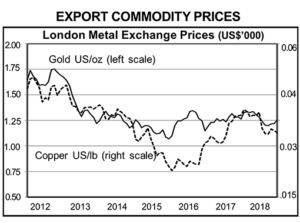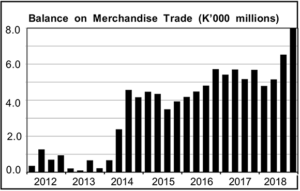The Bank of Papua New Guinea’s Quarterly Economic Bulletin reports sales were strong in the manufacturing and transportation industries during the September quarter of 2018. But in other sectors revenues were revealed to be either patchy or poor. David James analyses the data.
The Quarterly says the total value of sales in the formal private sector increased by 0.1 per cent in the September quarter of 2018, compared to an increase of 4.8 per cent in the June quarter.
But when the mineral sector is excluded the picture looks stronger. Sales increased by 4.7 per cent in the September quarter, compared with an increase of 2.6 per cent in the previous quarter.
Manufacturing rebounded. Sales increased by 29.9 per cent in the September quarter, compared with a decline of 13.1 per cent in the June quarter.
The ‘significant’ increase was partly due to higher production at the Napa Napa Oil Refinery after the earthquake in February of 2018.
‘Higher production of tinned fish and steel products also contributed to this increase,’ the document says.
In the transportation sector, sales increased by 14.9 per cent in the September 2018 quarter, compared with a decline of 0.6 per cent in the June quarter.
The increase was driven by ‘higher air passenger travel, and a pickup in activity in the trucking, shipping and stevedoring services.’
Transportation is experiencing a rebound. Over the year to September 2018, sales increased by 3.2 per cent, compared with a decline of 29.5 per cent in the corresponding period of 2017.
Primary industry
Primary industries were on an upward trajectory.
According to the document, the agriculture/forestry/fishing sector, sales increased by 2.9 per cent in the September quarter of 2018, following on from a sharp rise of 64.5 per cent in the previous quarter.
This was mainly attributed to ‘higher tuna catches, an improvement in the round log certification services and increased demand for pork meat.’
The document says this more than offset declines in the production of palm oil, cocoa and copra.
In the financial/business/other services sector, sales increased by 1.9 per cent in the September quarter.
‘Lower sales of vehicles, medical supplies, hardware goods, stationery supplies and other general merchandise goods accounted for the decline.’
This sector remains weak, but the rate of decline is slowing.
Weakness
Other sectors were weak too. Especially slow was construction, where sales declined sharply by 55.5 per cent in the September quarter following on from a decline of 46.3 per cent in the June quarter.
The drop was attributed to the near completion of several projects in the National Capital District, including the new Nambawan Plaza redevelopment of the Loloata Island resort and the Motukea wharf facilities.
In the retail sector sales fell by 6 per cent in the quarter, compared with a decline of 0.3 per cent in the June quarter.
‘Coffee volumes rose by 8.9 per cent to 52.1 thousand tonnes in 2018, while palm oil volumes fell slightly.’
‘Lower sales of vehicles, medical supplies, hardware goods, stationery supplies and other general merchandise goods accounted for the decline.’
In the wholesale sector, sales declined by 0.8 per cent in the quarter, compared with an increase of 16.6 per cent in the June quarter.
The falls was due to ‘lower sales of fuel by major fuel suppliers and lower sales of pharmaceutical items and other general merchandise goods.’
Volumes

Export commodity prices, gold and copper, according to the London Metal Exchange. Credit: Bank of PNG
Sales in the mineral sector declined by 6.0 per cent in the September quarter, compared with an increase of 7.2 per cent in the previous quarter.
Export volumes were also down. The volume of gold exported fell 6.8 per cent in 2018 to 58.7 tonnes.
Copper volumes fell 13.2 per cent in 2018 to 87.4 tonnes; nickel volumes fell 27.9 per cent to 25.8 thousand tonnes in 2018, and cobalt volumes over the same period fell 14.7 per cent to 2.9 thousand tonnes.
Overall, higher prices compensated for the lower volumes—receipts were up 8.6 per cent to K27.578 billion in 2018.
Coffee volumes rose by 8.9 per cent to 52.1 thousand tonnes in 2018, while palm oil volumes fell slightly.
Cocoa volumes rose 4.3 per cent in 2018 to 33.3 thousand tonnes, a jump that the Quarterly attributed to ‘the implementation of the intervention programs carried out by the Cocoa Industry Authority to improve production.’









Speak Your Mind